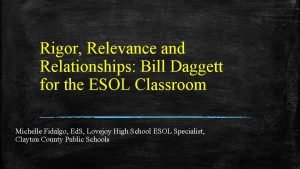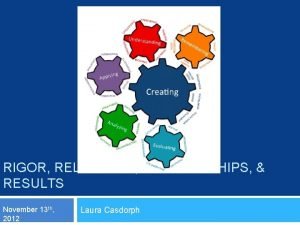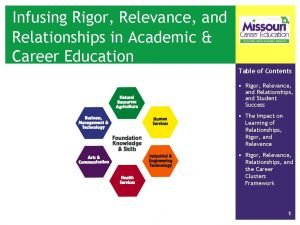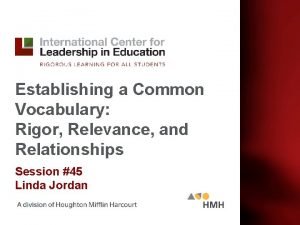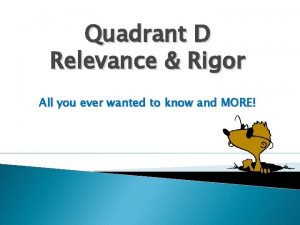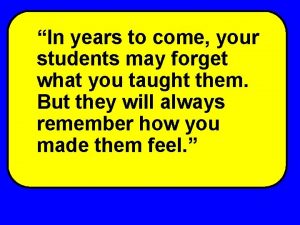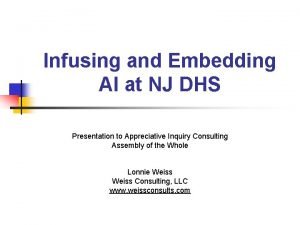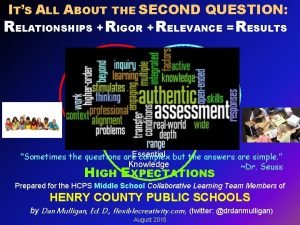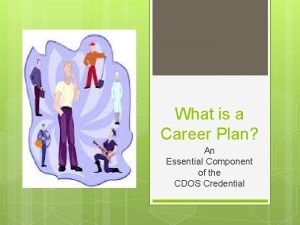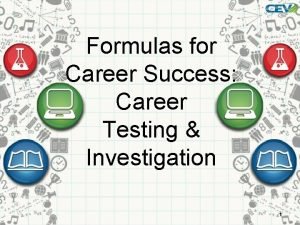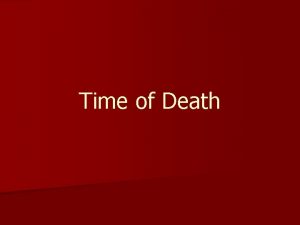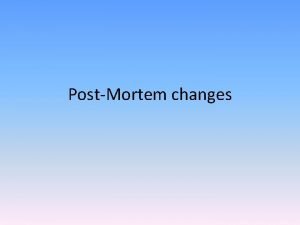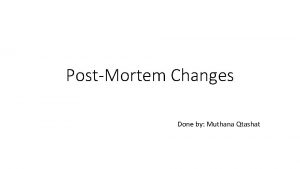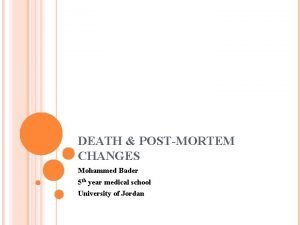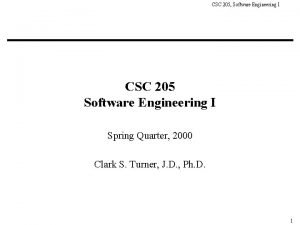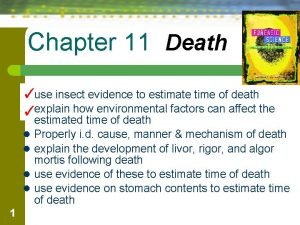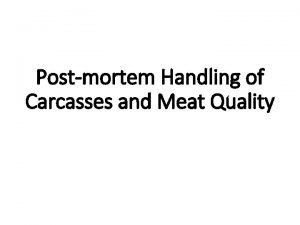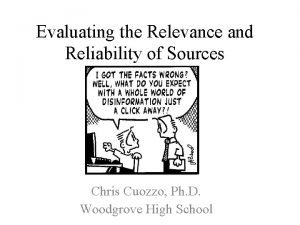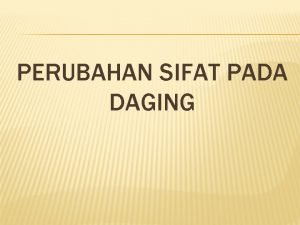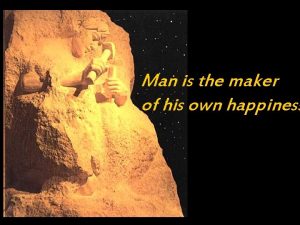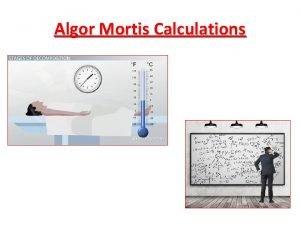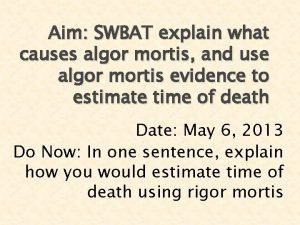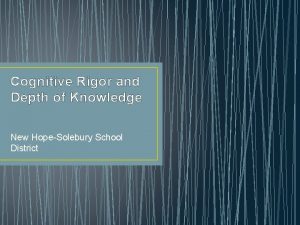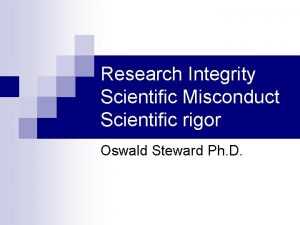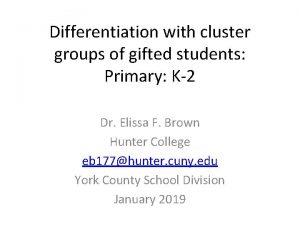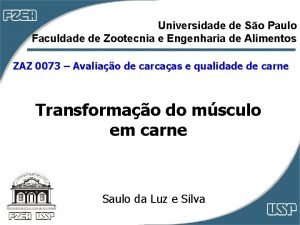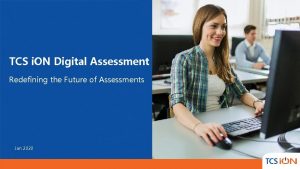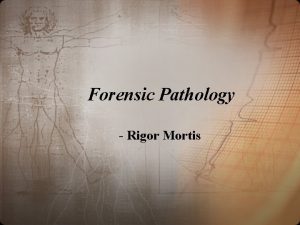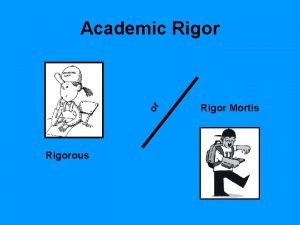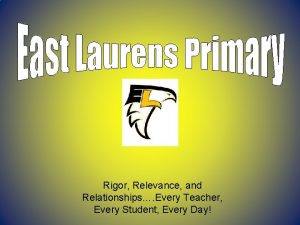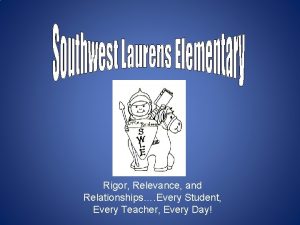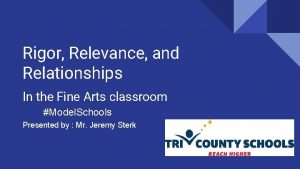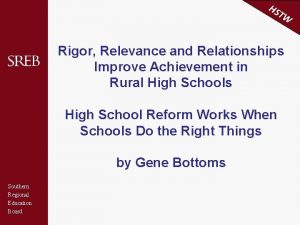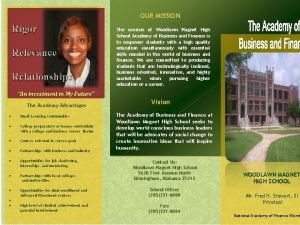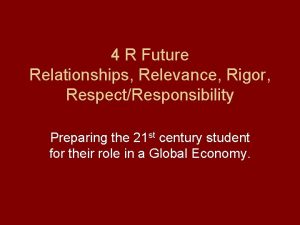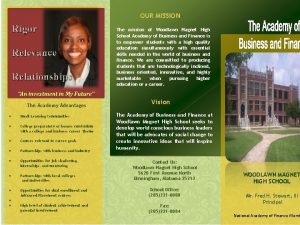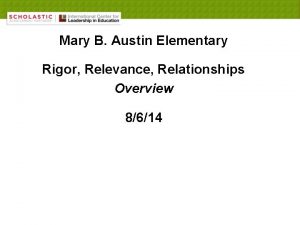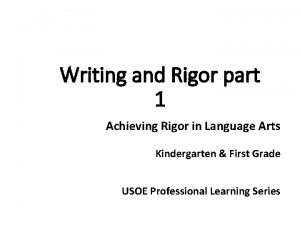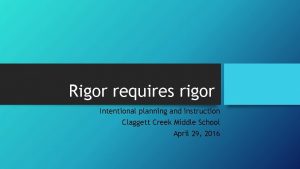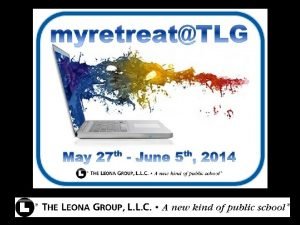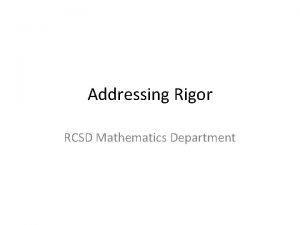Infusing Rigor Relevance and Relationships in Academic Career































- Slides: 31

Infusing Rigor, Relevance, and Relationships in Academic & Career Education Table of Contents • Rigor, Relevance, and Relationships, and Student Success • The Impact on Learning of Relationships, Rigor, and Relevance • Rigor, Relevance, Relationships, and the Career Clusters Framework 1

Module Objectives This module will help you: § Understand the importance of relationships and how they are established in school systems § Define rigor and how schools ensure rigorous instruction § Specify the rationale for and how to create relevance in classrooms § Identify how to incorporate relationships, rigor, and relevance into the Career Clusters Framework 2

Module Overview § Rigor, Relevance, and Relationships, and Student Success § The Impact on Learning of Relationships, Rigor, and Relevance § Rigor, Relevance, Relationships, and the Career Clusters Framework 3

Rigor, Relevance, and Relationships and Student Success This section covers: § Meaningful, challenging instruction and feeling connected § Understanding challenging concepts in application § The support of relationships for learning § Opportunities for high-level thinking and challenging content “Children learn best if they are immersed in complex experiences and are given the opportunity to actively process what they have learned. ” Renata Nummela Caine 4

Meaningful, Challenging Instruction & Feeling Connected From Devin’s Story: Devin begins the conversation: “I don’t see what the big deal is. I don’t really need to know these subjects. They are boring. Besides, at Tech they tell me I’m doing great. In fact, they tell me I’m the best they have seen in a while and that they will write me letters to get into IT. ” “Traditional” school is boring to students who crave relevance. The answer to, “Why do I need to learn this? ” is not, “Because I said so. ” The answer is to link the learning to relevant work that interests the students. Clearly, that’s what’s going on at Tech. Devin is not bored—he is excelling in his work there because it is meaningful (relevant), challenging (rigorous), and because he feels connected to the content and the teachers (relationships). 5

Understanding Challenging Concepts in Application From Devin’s Story: Devin’s father, angry and confused, speaks up: “I don’t understand how you can excel in a technical field, and that is what he says he is being told by his teachers at Tech, but be failing Geometry and Science. What is going on here? ” Devin clearly seeks relevance in his academic studies. He needs to understand how his booklearning will apply to real life. Devin can understand challenging concepts in application, but is bored by academic abstraction. 6

The Support of Relationships for Learning From Devin’s Story: The assistant principal asks Devin to step back into the office. “Devin, ” he asks, “what do you think caused your performance in geometry and biology to decline so much in the second quarter? Your first quarter grades, all C’s, were not stellar but they were not failing like they are now. ” “I don’t know, ” replies Devin. “I told you these high school courses are boring. There’s a lot of reading, and I don’t like to read that much. I read a couple of pages and can’t remember what I have just read. How am I ever going to learn if that happens? ” Devin is capable of applying the concepts in the challenging material, which he has proven at Tech. His diagnosed learning disability and his own preferences indicate that reading is a challenge. There are many ways to learn, many channels for intake of information. Devin needs the support of relationships to offer multiple pathways for learning information. But he also craves the opportunity to apply the concepts — the relevance that makes rigor possible. His relationships with the staff at Tech motivate Devin to achieve. 7

Opportunities for High-level Thinking and Challenging Content From Devin’s Story: The core problem, it seems to the assistant principal, is not that multiple curriculums exist. In fact, varied courses of study are enriching. The problem, it seems, is that even after tracking, there are biases at play in who gets what curriculum. Furthermore, the curricular options are built on terribly diminished and selffulfilling assumptions about the cognitive capacity of technical students. Every subject matter contains the opportunity for “high-level” thinking and challenging content. All students deserve to learn challenging content — including those who like to work with their hands. Powerful learning is both “head work and hand work. ” 8

The Impact on Learning of Relationships, Rigor, and Relevance This section covers: § Relationships § Rigor § Relevance § Balancing all three factors “The great waste in the school comes from the child’s inability to utilize the experiences he gets outside of school in any complete and free way within the school itself; while on the other hand, the child is unable to apply in daily life what he is learning at school. ” John Dewey 9

The Importance of Relationships: § Connect students to school § Fill a need for social interaction “No significant learning occurs without a significant relationship. ” § Form “bridges” from: – Middle school to high school – High school to postsecondary education or quality employment James Comer 10

The Importance of Rigorous instruction demands that students learn to perform at proficient and advanced levels on high-stakes assessments. Rigor involves: Rigor is when something is challenging and complex. § Aligning learning objectives and assessments to standards § Targeting instruction within the ZPD “Zone of Proximal Development” § Promoting complex, sophisticated thought 11

The Importance of Relevance provides context. Relevance: § Answers, “Why do we have to learn this? ” § Links to “now” § Connects present lessons to past lessons, creating and reinforcing neural pathways in the brain 12

Balancing Rigor, Relevance, and Relationships For example: Consider the learning activity, “Compare the literary style of two different authors. ” What level of rigor, relevance, and relationships does this activity reflect? (Level) Rigor Relevance Relationships HIGH X Requires analysis (complex thinking) Task does not specify an application or real-world connection LOW Assignment to be completed by an individual in isolation X X 13

Exercise 1: Balancing Rigor, Relevance, Relationships Objective: Rank the level of rigor, relevance, and relationships in learning activities. Instructions: In your workbook (on page 20), complete the chart by ranking the level of rigor, relevance, and relationships (as either “high, ” “medium, ” or “low”) in each of the following learning activities: 1. Read a recipe for making bread. 2. Plot the coordinates for a quadrilateral on a grid. 3. Work with a team to collect data and make recommendations to address an environmental concern. 4. Use tessellation to create an original artistic design. 5. Write and direct a one-act play. 6. Memorize the Periodic Table of Elements. 7. Discuss, in a small group, how the events in a novel relate to nonfiction current events. Next-Step Activity: Share this activity with others in your school/district. Discuss with them the following: § What did you notice about the low-rigor learning activities? 8. Create a collage illustrating positive and negative space. § What did you notice about the high-relationship activities? 9. Mentor an elementary student learning to speak simple Mandarin Chinese conversational phrases. § How might the level of relevance in a learning activity affect both rigor and relationships? 10. Work in a crew to design and construct a garden shed. 14

Rigor, Relevance, Relationships and the Career Clusters Framework This section covers: § Definitions of rigor, relevance, and relationships within the Career Clusters Framework § Links between rigor, relevance, and relationships and the elements of the Career Clusters Framework § Tools within the Career Clusters Framework for infusing rigor, relevance, and relationships “The best way to learn is not through lecture, but by participation in realistic situations that learners try new things in safe environments. ” Willard Daggett 15

Definitions within the Career Clusters Framework § Rigor — Learning experiences in which students demonstrate a thorough, in-depth mastery of challenging tasks that foster cognitive skills § Relevance — Learning experiences in which students apply core knowledge, concepts, or skills to solve real-world problems § Relationships — Four critical learning connections formed among: 1. 2. 3. 4. Students, parents, peers Staff members Teachers with others in their profession Schools and communities (parents, businesses, community leaders) 16

Links between Rigor/Relevance/Relationships & the Career Clusters Framework Element Demonstrates Rigor Relevance Relationships X X X Transitions X X X Integration X X X Personal Plan of Study X X X Career Clusters Programs of Study 17

Career Clusters Tools for Infusing Rigor, Relevance, & Relationships Tools for infusing rigor: § § § Programs of study Course alignment to GLEs/CLEs, standards, knowledge & skills statements College readiness skill preparation Advanced courses ü Dual credit/dual enrollment ü Advanced placement ü International Baccalaureate (IB) Capstone experiences 18

Career Clusters Tools, Continued For infusing relevance: § Career clusters § Personal plans of study § Integration of academic and career-technical education § Work-based learning/work-site learning § Tech prep § Active learning instructional strategies § Project-based learning & problem-based learning § Career-based learning 19

Career Clusters Tools, Continued For infusing relationships: § Individual, person-to-person activities § Programs or programmatic efforts § Institutions or organization-wide operational initiatives § Consortia, or cross-institution cooperative agreements 20

Tools — Relationships: Individual, Person-to-Person Activities § Active listening • Identifying unique talents § Taking interest • Celebrating accomplishments § Showing respect • Serving as a role model § Making frequent contact • Communicating on a one-toone basis § Demonstrating encouragement • Showing enthusiasm § Avoiding “put downs” • Using positive humor § Displaying student work 21

Tools — Relationships: Programs, Programmatic Efforts § Programs that build emotional intelligence: – Character education – Service learning § Programs that facilitate academic transitions: – – Summer Bridge & freshman transition courses Advisement & advisory periods Personal plans of study Mentoring § Programs that apply academics to career opportunities: – Integrated academic/CTE courses – Career Clusters Framework 22

Tools — Relationships: Organization-wide Operational Initiatives § Small Learning Communities Note: § Professional Learning Communities For more information on these initiatives, check out the links at the end of this presentation. § Making Middle Grades Work § High Schools That Work § Technology Centers That Work § Project Lead the Way § Model Schools Initiative 23

Tools — Relationships: Cross-Institution Cooperative Agreements Various institutions can collaborate to create structures that facilitate relationship building, such as: § Events/Activities: – – Orientation to middle school Pre-enrollment advisory High school orientation Postsecondary campus tour § Career Goal Implementation Plans – Personal plan of study – Career Clusters Framework – Programs of study § Policies/Agreements – Articulation agreements – Dual credit/dual enrollment courses – Transfer policies 24

Exercise 2: Identifying Rigor, Relevance, Relationships Objective: Utilize district publications (print or online) to identify existing programs offering rigor, relevance, and relationships. Instructions: Review the student handbook excerpt in your Next-Step Activity: workbook on page 27 through 32. Find evidence of rigor, relevance, and relationships, and record what you found on page 22 of your workbook. Look for evidence of the following and determine if those programs reflect rigor, relevance, or relationships: Look at the student handbook for your institution/district. • Activities/clubs/student life • Service learning/community service • Internships/practicum • Parent/teacher meetings § International Baccalaureate (IB) § Tutoring strategies § Advanced placement What evidence is there of rigorous learning, relevant experiences, and programs that enhance relationships? Discuss what you find with others at your institution. 25

Exercise 3: Creating Your Personal Action Plan Objective: Develop a personal action plan to improve rigor, relevance, and relationships at a specific institution. Instructions: Complete at least two items per category below (in your workbook on page 23). Then, list two to three action steps that you can personally take within the next four weeks to facilitate each of your suggestions. The rigor in my institution would improve if only… The relevance in my institution would improve if only… The relationships in my institution would improve if only… 1. 1. 2. 2. 3. 3. Next-Step Activity: Meet with teachers and others at your institution to brainstorm improvements to rigor, relevance, and relationships. Together, create a team action plan for implementing the improvements you agree on. 26

Developing Action Plans For more help developing action plans that enhance rigor, relevance, and relationships in your institution/district, contact: § Missouri Center for Career Education — www. mcce. org § Department of Elementary and Secondary Education — www. dese. mo. gov 27

Additional Resources § Career Clusters — www. careerclusters. org § High Schools That Work — http: //www. sreb. org/Programs/hstwindex. asp § Model Schools Initiative (International Center for Leadership in Education) — www. leadered. com § Project Lead the Way — www. pltw. org § Missouri Connections — http: //www. missouriconnections. org/ § Missouri Center for Career Education — http: //missouricareereducation. org/ § Missouri Department of Elementary and Secondary Education — www. dese. mo. gov 28

Infusing Rigor, Relevance, and Relationships: Module Review § “Traditional” school is boring to students who crave relevance. The answer is to link learning to relevant work that interests the students. § Once “hooked” with learning that is relevant, students can be challenged with rigorous content that meets academic and industry standards and promotes complex, sophisticated thinking. § Relationships help students feel connected to school and form “bridges” from middle school to high school as well as from high school to post-secondary education or employment. 29

Infusing Rigor, Relevance, and Relationships: Module Review • In addition to student-school relationships, other relationships bear on the success of programs that support student transitions. These include relationships among staff members, between teachers and others in their profession, and between schools and their communities (e. g. , parents, businesses, community leaders). • Elements of the Career Clusters Framework support rigor, relevance and relationships: Programs of study support rigor; personal plans of study link to relevance; and transitions and integration are forged through relationships. 30

“Research consistently supports that practice and actually using knowledge leads to the greatest retention and learning. ” Source: Willard Daggett 31
 Rigor relevance relationships
Rigor relevance relationships Rigor relevance and relationships in action
Rigor relevance and relationships in action Rigor relevance and relationships in action
Rigor relevance and relationships in action Rigor relevance and relationships in action
Rigor relevance and relationships in action Rigor relevance framework
Rigor relevance framework Rigor relevance quadrants
Rigor relevance quadrants Rigor and relevance checklist
Rigor and relevance checklist Destiny 2 infusing
Destiny 2 infusing Relationships before rigor
Relationships before rigor Pretest: developing an academic and career plan
Pretest: developing an academic and career plan National career clusters framework
National career clusters framework Formulas for career success: résumés - assessment
Formulas for career success: résumés - assessment Mortisn
Mortisn Rigor
Rigor Post mortem suggillation
Post mortem suggillation Post mortem changes
Post mortem changes Rigor mortis vs livor mortis
Rigor mortis vs livor mortis Rigor and formality in software engineering
Rigor and formality in software engineering Rigor mortis and livor mortis
Rigor mortis and livor mortis Cold shortening and thaw rigor
Cold shortening and thaw rigor Chris cuozzo
Chris cuozzo Relevance lost the rise and fall of management accounting
Relevance lost the rise and fall of management accounting Apa itu pre rigor
Apa itu pre rigor Man is the
Man is the Rigor mortis eyes
Rigor mortis eyes How to calculate algor mortis
How to calculate algor mortis Determining time of death worksheet
Determining time of death worksheet What is cognitive rigor
What is cognitive rigor Scientific rigor definition
Scientific rigor definition Rigor is
Rigor is Resolução do rigor mortis
Resolução do rigor mortis Rigor in operations tcs
Rigor in operations tcs
